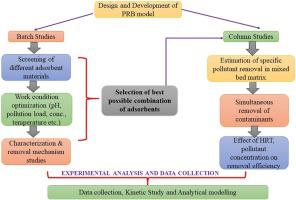Journal of Water Process Engineering ( IF 6.3 ) Pub Date : 2020-06-30 , DOI: 10.1016/j.jwpe.2020.101471 Akshit Mittal , Rahul Singh , Sumedha Chakma , Gaurav Goel

|
In this study, different by-product wastes, i.e., fly ash (FA) and rice husk (RH), were analyzed in various proportions with other materials, i.e., activated carbon (AC), activated alumina (AA) and quartz sand (QS), for the remediation of NO3− and PO43- using Permeable Reactive Barrier (PRB) generated from pit-toilet leachate. Initially, a batch analysis was conducted for finding the optimum material composition considering various significant parameters, viz., pH, temperature, initial concentration, and dosage. The experimental results suggest that NO3− and PO43- were successfully removed, following the adsorption mechanism, with an efficiency of more than 95 %. This removal efficiency was obtained with a mixture of AC, RH, AA, QS, and FA in a weight proportion of 1:2:1:2:4 at a controlled pH value of 6. Langmuir isotherm model showed the most effective results with a coefficient of determination (R2) of 0.975 with a maximum sorption capacity of 32.6 mg g-1 and 46.5 mg g-1 for removal of NO3− and PO43- respectively. The adsorption kinetic data, for both NO3−and PO43-, provided better relationships with the pseudo-first-order model. Further, continuous fixed-bed column analysis manifested that at 10 mL min-1 flow rate and 600 mg L-1 initial concentration of both NO3− and PO43-, the reaction zone of the barrier provides a higher saturation time. Similarly, the retention time of contaminant water was also found to be higher at 45 cm bed depth. Furthermore, an adsorption-desorption regeneration test observed a decent amount of material recovery after full exhaustion of reactive bed.
中文翻译:

渗透反应屏障技术,修复了坑厕渗滤液中被硝酸盐和磷酸盐污染的地下水
在这项研究中,对不同的副产品废物,即粉煤灰(FA)和稻壳(RH),与其他材料,即活性炭(AC),活性氧化铝(AA)和石英砂( QS),对NO的补救3 -和PO 4 3-使用从坑马桶渗滤液产生可渗透反应屏障(PRB)。最初,进行批处理分析以考虑各种重要参数(例如,pH,温度,初始浓度和剂量)来找到最佳的材料组成。实验结果表明,NO 3 -和PO 4 3-按照吸附机理成功去除了三氧化二砷,效率超过95%。在控制pH值为6的情况下,使用重量比为1:2:1:2:4的AC,RH,AA,QS和FA的混合物可获得这种去除效率。Langmuir等温模型显示了最有效的结果判定(R的系数2的0.975)与32.6毫克g的最大吸附能力-1和46.5毫克克-1用于去除NO的3 -和PO 4 3-分别。吸附动力学数据,对于NO 3 -和PO 4 3-提供了与伪一阶模型更好的关系。此外,连续式固定床柱分析表现,在10毫升分钟-1的流速和600毫克的L -1两者NO的初始浓度3 -和PO 4 3-,阻挡的反应区域提供了更高的饱和时间。同样,在床深45厘米处,污染物水的保留时间也更长。此外,吸附-脱附再生测试观察到反应床完全耗尽后材料回收率相当高。











































 京公网安备 11010802027423号
京公网安备 11010802027423号